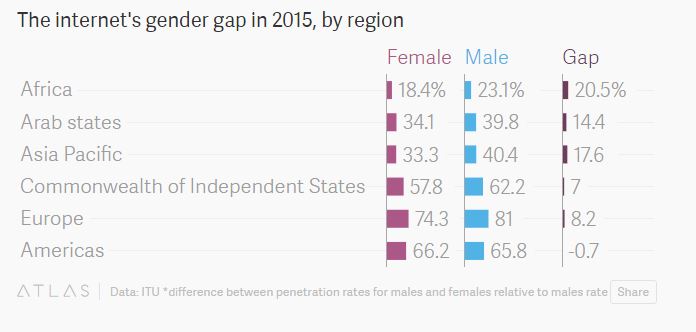The state of internet connectivity around the world
Stay up to date:
Digital Communications
This article is published in collaboration with Quartz.
This we know: The next billion people who are coming online will do so from cheap, mobile phones. While the cost of phone service is falling globally, fixed broadband—typically more reliable and faster than cellular connections—is actually becoming more expensive in the poorest countries.
This week, the International Telecommunication Union, an arm of the United Nations, released a report on global connectivity. It estimates that 3.2 billion people—43.4% of the world’s population—will use the internet in 2015, but that figure falls to 9.5% for the least developed countries, which the UN defines as the “poorest and weakest segment of the international community.” (These countries represent about 880 million people—about 12% of the world’s population—but make up less than 2% of the global gross domestic product.)
Around the world, there remains a large gender gap in who uses the internet. In the least developed countries, only 8% of females will have used the internet in 2015 compared with 11.3% of males. Those statistics echo a September UN report that found that women in low- and middle-income countries are 21% less likely to own a mobile phone, helping perpetuate inequality between men and women. The ITU has set a goal to achieve gender equality among internet users by 2020.
Here’s the same breakdown by region:
Overall, the internet is becoming more accessible. The price of mobile service is falling, with developing countries seeing costs fall by between 15% and 25% from 2013 to 2014. But service still remains more expensive for developing and least developed countries when looking at the cost as a percentage of their gross national incomes (GNI) per capita, a metric the ITU uses to make a more apples-to-apples comparison across countries with vastly different economies.
While mobile phone service is generally more expensive in poorer countries, that’s not the case across the board. Countries, such as Sri Lanka (ranked No. 12 when looking at the cost of service relative to its per capita GNI), Iran (No. 17), China (No. 34), and Mauritius (No. 35)—all of which rank higher than the US (No. 35)—have driven competition and provided regulatory incentives for telecom operators to lower their prices.

It’s a different story with broadband connectivity, which is becoming less accessible for poor countries. Globally, broadband prices were trending down until 2013—and then they stagnated, and in some countries, actually rose.
For the least developed countries, the average cost grew 70 to 98%, “a sharp increase that will certainly not improve the already very low uptake of fixed-broadband in the world’s poorest countries,” said the report. The two charts below illustrate the upward trend in broadband prices for the least developed countries, both on a raw cost and GNI per capita basis.

But it’s Africa that’s hardest hit, with people paying 178% of their per capital GNI for access. There are, however, some African countries that buck this trend. In Seychelles, South Africa, Mauritius, Gabon, Cabo Verde, and Botswana, broadband costs are 5% or less of GNI per capita, a rate that rivals many developed countries.

The chart above illustrates the breakdown of broadband costs across African countries. It’s especially striking when you compare the y-axis values against the same chart for Europe (below).

The ITU has set a goal for broadband services to cost no more than 5% of average monthly incomes in developing countries by 2020. This will be an especially challenging problem to fix, given the infrastructure involved to expand fixed broadband access. Even Facebook and Google—two tech giants that are working to bring connectivity to as much of the world as they can—aren’t looking at laying down cables. They instead have ambitious plans to bring fast internet via the air: balloons,drones, satellites, and lasers.
Publication does not imply endorsement of views by the World Economic Forum.
To keep up with Agenda subscribe to our weekly newsletter.
Author: Alice Truong is Quartz’ senior Silicon Valley correspondent.
Image: Internet LAN cables are pictured. REUTERS/Tim Wimborne.
Don't miss any update on this topic
Create a free account and access your personalized content collection with our latest publications and analyses.
License and Republishing
World Economic Forum articles may be republished in accordance with the Creative Commons Attribution-NonCommercial-NoDerivatives 4.0 International Public License, and in accordance with our Terms of Use.
The views expressed in this article are those of the author alone and not the World Economic Forum.
Forum Stories newsletter
Bringing you weekly curated insights and analysis on the global issues that matter.
More on Fourth Industrial RevolutionSee all
Daniel Dobrygowski and Giannis Moschos
May 21, 2025
Chiara Barbeschi and Luna Rohland
May 21, 2025
Jane Thoning Callesen
May 20, 2025
Sebastian Buckup
May 19, 2025
Jovan Jovanovic and Dino Osmanagić
May 16, 2025
Elena Fersman
May 14, 2025







